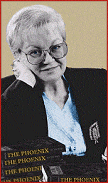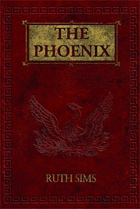 Introducing
Ruth Sims and her novel The Phoenix... Introducing
Ruth Sims and her novel The Phoenix...
|
 The
Phoenix The
Phoenixby Ruth Sims (website) 352 pages, paper, $16.95 Writers' Collective ISBN: 1932133402 [Note: this is a reprise from my Foreword review, but with more detail] Like Tess of the d’Urbervilles or Wilkie Collins’ The Woman in White, this Victorian novel is replete with plot twists, years-long detours, providential meetings, villainy, and a great deal of drama. And yet like Laura Argiri's The God in Flight , it differs from most other Victorian novels in that the two main characters who meet and fall in love are both men. One is an adopted son with a dark secret and a Dickensian background who has taken on a new identity, and the other is an uptight doctor with a strong religious background that would have made any Puritan proud. Kit St. Denys, who began life as Jack Rourke (a street thief and pickpocket), is an up-and-coming actor in London. He has gone from poverty and abuse at fourteen when he fatally stabs his abusive father, to riches when he is adopted by a man who introduces him to the world of the wealthy and the theatre. Nick Stuart, the young doctor, is a troubled man who becomes estranged from his strict, unforgiving father when he goes off to medical school. Although his father is also a doctor, he is unwilling to allow his son to step beyond the small village and turns his back on Nick when he leaves home. Kit and Nick meet after one of Kit’s critically acclaimed performances and, from there, they begin a troubled but madly-in-love relationship that takes many years to resolve. In telling the story, Ruth Sims doesn't shirk her Victorian responsibilities. She meticulously and in a most interesting way takes time to tell the back stories of each of the main characters. By the time Kit and Nick meet, readers already know of Kit's past life, of the death of his brother at his father's hands, of his mother's abandonement of him and his brother and their abusive father, and how Kit comes to be "adopted" by his rich benefactor. Readers already know of Nick's back-story as well, and of his first experience with another boy in his village, how it both awakened him to that side of himself, as well as frightened him of the damnation in it if he ever followed through with such feelings. Further, Nick’s religious background causes him the deepest pain in loving Kit. “He loved Kit in the way God meant him to love a woman. It was as simple and as soul-damning as that.” While this problem should have been enough to doom their relationship, Kit has demons of his own, never able to shake the nightmares of his father’s abuse, nor of the night he left him for dead. “The old man wrestled with him. Seized his hand. Forced it down upon … Michael’s rotting flesh ... His hands sank into soft eyes, into putrefying brain.” But like any good Victorian novel, these problems are not enough to keep Kit and Nick from a deep love for each other. Nor is a whole host of plot twists, including marriage, time, and distance. It is these plot twists, which I won't reveal, that make this a proper Victorian read. And Sims writes with authority of the times in which the book is set. From the drawing rooms of high-society England in the latter part of the 19th Century, to the days in New York City when the Trusts owned all the theatres, or controlled them so thoroughly that a play did not get a billing unless it was approved by the trust. There is also a convincing description of Circus life, and that of life "out West" in America of the 19th Century. And yet, Kit and Nick persevere through numerous reversals of fortune, years of estrangement, entanglements, and madness in a “snake pit” even Joan Crawford would find disheartening. Those who enjoy historical fiction and Victorian novels, especially, will become enthralled with The Phoenix. Sims fulfills the implied promise an author makes to readers to bring all the subplots together in a logical and satisfying resolution at the end. The main characters and supporting cast are fully developed and ones readers will believe; and like any good Victorian novel, the villain is one who can be booed and hissed off stage, without being melodramatic. —Ronald L. Donaghe
|
Bio Ruth Sims is an anomaly. A cookie-baking Midwestern grandma, she's the homemaker-next-door who whips up meals from scratch, likes to iron, and uses a clay flower pot as a chicken roaster. And she's hardly ever ventured beyond the borders of rural Illinois. So why the anomaly? Because her conservative upbringing was left in the dust when she wrote The Phoenix, a gay love story. Though there are no degrees after her name (formal education ended with High School) self-education began with the first book she ever picked up and hasn't stopped since or even slowed down a tad. Her personal library contains books that run the gamut from Forensic Medicine to Latin, Comparative Religions to Gay History, many biographies, and gutter slang in four languages. Add a love of great literature and a delight in creative wordplay, and you get a writer with an imagination that takes her satisfied readers everywhere they want to go. She is currently working on another gay novel, Counterpoint. Counterpoint is another Victorian (I love that period in case you didn't guess.) It's more a clash of class and cultures complicating the love between two musicians. As usual with my books, it starts when the characters are young, in their mid-teens. One is an English-born gypsy violinist, Geoffrey Dohnonyi, whose mother was a gentlewoman with romantic ideas about gypsies until she runs headlong into their lifestyle when she elopes with one. I've done a lot of research into the gypsy life. The other is Dyland, an upper middle-class young man whose father wants him to do something useful with his life, not waste it composing music, though the character, Dylan, has the talent and rebelliousness to be a barrier-breaking composer. Another character is a famous Machiavellian violinist who, through Geoffrey's mother's maneuvering becomes both Geoffery's mentor and his bete noir. Another character is Laurence, a classical history master at the school Dylan attends, a man who is wise beyond his years and who becomes Dylan's first lover. I don't envision it as having a happily-ever-after ending at all, although I see it ending with Dylan's final truth that no matter what else he loses he will always have his first and deepest love—music. Ruth Sims' Phoenix Available through Ingram or Midpoint Trade Books Phone orders: 800-497-0037 Email orders: Orders@Midpt.com Author's email: rsims@writerscollective.org |